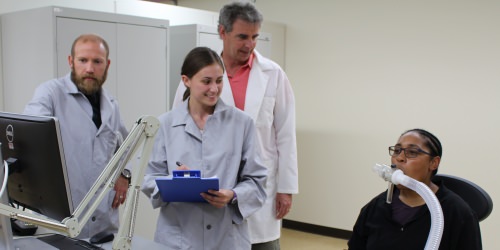Directory of resources for researchers now available
Looking for DNA sequencing services on campus? How about exercise equipment for a wellness study? Or an electro-acoustic research space that is designed to be a comprehensive facility that can provide the equipment necessary to fulfill the creative dreams of users, without limitation? A new directory that provides listings for hundreds of shared research resources is now available.
The Directory of Resources for Researchers is a product of the Office of Campus Cores located within the Office of the Vice Chancellor for Research and Graduate Education.
The directory is accessible from the research.wisc.edu website.
Research cores are centralized, shared research resources that provide access to instruments, technologies, services, as well as expert consultation, training and other services to campus researchers.

Among the resources featured in the directory: The new Human Exercise Core, which supports exercise and metabolism-related research. (Photo by Steven Wright)
“This is the first centralized, publicly searchable directory of shared research resources, services and cores at UW–Madison,” explains Marsha Mailick, vice chancellor for research and graduate education. “The directory is comprehensive in scope, including biological sciences, physical sciences, social sciences, and arts and humanities. It is this scope that truly makes the UW–Madison research cores directory unique among our peer institutions, whose efforts are typically limited to medical schools or biological sciences.”
Isabelle Girard, director of the Office of Campus Cores, explains that information in the directory is organized using categories and controlled keywords so related resources are easily located. The shared resources directory provides information about equipment and instruments, but also databases, technologies, services, training, expertise and consultation.
“Because of the large size of campus, finding resources at UW–Madison can be challenging,” Girard says. “The directory makes finding resources and access to cutting-edge technologies and world class experts easier and faster. The directory also fosters interdisciplinary research and can be a recruiting and onboarding tool for faculty, staff researchers and graduate students.”
Collecting data in the directory will be ongoing and the directory will increase the visibility of core resources to campus researchers.
Gary Diffee is the principal investigator for the UW2020: WARF Discovery Initiative project, “Human Exercise Research Core Facility to Serve the Broader Campus.” The new Human Exercise Core will be included in the directory.
“This new directory is arriving at a great time as we just get our Human Exercise Research Core facility up and running,” says Diffee. “There is increasing importance placed on exercise and exercise-related testing in a large number of research areas and research subject populations. However, not everyone working in those research areas has the expertise and equipment to conduct the appropriate tests. We are hoping that the visibility to this new Exercise Core facility provided by the directory will dramatically affect the use of this facility for anyone interested in conducting exercise- and metabolism-related research on this campus.”
The facility will provide a centralized space for measuring several aspects of exercise and physical function, including exercise capacity, exercise metabolism, cardiopulmonary function, muscle function and body composition. For investigators new to this type of research, the core will provide both access to equipment and access to experts with expertise in these measures. Physical activity research has recently been listed as one of the priority areas for the National Institutes of Health, It is hoped that this new core will boost funding potential, catalyze collaborative initiatives, and enhance research impact for a diverse array of researchers on campus.




